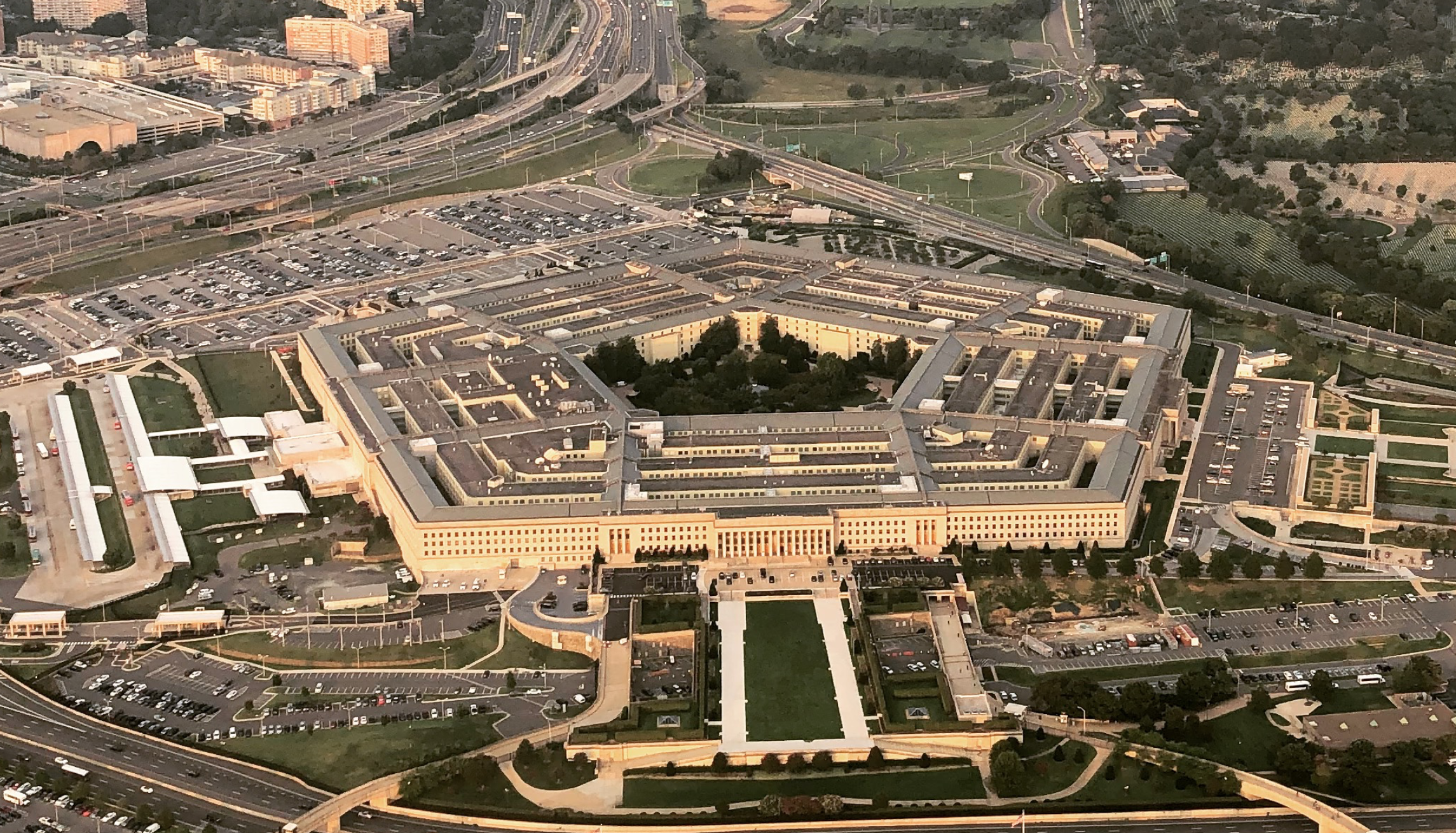Why National Security Agencies Must Analyze Climate Risks
The use of climate risk analytics is needed to fulfill President Biden’s focus on climate and help protect the U.S. from a major threat multiplier.

Published by The Lawfare Institute
in Cooperation With

July marked the initial deadline for the Pentagon and other federal agencies to draw up plans for potential climate risks, under an executive order by President Biden. Such plans are an essential first step, but the greater challenge for national security agencies is to continue to redirect their focus to changing climate conditions that pose a complex, two-pronged threat: social and political instability overseas and damage to U.S. infrastructure.
Climate change is accelerating geopolitical tensions in many regions of core strategic interest to the United States. Increasingly destructive storms, rising seas and the melting Arctic are fueling global tensions, with nations bracing for mass migrations of displaced people and vying to take advantage of newly accessible natural resources. Changing climate patterns have become a catalyst for internal conflicts and international unrest, with severe droughts playing a role in setting the stage for the Syrian civil war and shrinking lake levels in Lake Chad contributing to widespread violence across the four African nations of the lake’s basin.
Even in places where climate change has not sparked conflicts directly, it looms as a threat multiplier, exacerbating competition for food and water and worsening ethnic tensions. The Defense Department highlighted these risks earlier this year in its first climate and environmental security tabletop exercise, known as Elliptic Thunder. Set in East Africa and based on climate, economic and population forecasts, the multiagency exercise highlighted the extent to which climate change can worsen natural disasters and trigger regional instability, opening the door for strategic rivals and extremist groups to gain power.
Closer to home, altered weather patterns and warming temperatures are battering military installations across the nation. From the devastating impacts of Hurricane Michael on Tyndall Air Force Base in Florida to the thawing and erosion in Alaska that is undermining the foundations of vital radar facilities, climate change is costing billions of dollars while degrading U.S. military readiness. More broadly, coastal surges, floods, heat waves and wildfires are exacting a toll on U.S. transportation networks and energy systems, threatening supply disruptions and increasing the cost and complexity of potential defense operations.
As climate change becomes a central focus for national security policymakers, scientists are gaining new insights into the complex interconnections of Earth’s climate system. By collaborating with a range of stakeholders, they also are helping to develop actionable projections of climate impacts in specific regions.
In one notable breakthrough, for example, a research team drew on the complex interactions of the ocean and atmosphere to demonstrate that changes in Arctic sea ice coverage can be predicted several years in advance. This is critical for U.S. security interests at a time when changing ocean circulation patterns and salinity are affecting how submarines maintain their stealthy features and track Russian and other activity in the warming Arctic. Russia is taking advantage of a warming climate to rearm in the Arctic, conducting high-profile military exercises in the region earlier this year and launching increasingly powerful icebreakers while President Vladimir Putin pledges to reinforce his nation’s presence in the region. Also looming are growing international tensions over trillions of dollars of natural resources that are becoming more accessible because of retreating sea ice.
Looking further into the future, scientists are studying how storms are likely to shift later this century in ways that may lead to widespread flooding or lightning-induced wildfires in parts of North America and overseas regions. This type of research is critical for designing more resilient infrastructure and anticipating shifts in weather patterns that can displace vulnerable populations.
To enhance understanding of how the climate is likely to change and the extent to which reductions in greenhouse gas emissions could lessen future impacts, the government must boost funding for science in ways that can support decision-makers. The research and analysis community needs more powerful supercomputers, next-generation observing tools such as advanced satellites and enhanced models of regional climate conditions, along with improvements to such cutting-edge techniques as artificial intelligence.
Investments in climate research and analytics will more than pay for themselves by producing increasingly detailed and reliable projections of the climate threats the U.S. faces at the regional scale at which decisions are made and conflict arises. This will produce economic benefits as well, with private firms already generating jobs that provide climate risk services to many sectors of the economy, from real estate to banking.
Climate risk analytics, properly deployed, will also strengthen the nation’s resilience to extreme events, ranging from the type of frigid outbreaks that crippled electric and water systems across Texas and neighboring states last winter to the summer heat and extreme drought that now threaten the West. Engineers, equipped with detailed information about the heightened risk of such environmental factors as sea level rise and increasingly severe flooding, will be better equipped to safeguard military bases from the impacts of changing climate. Such impacts will be particularly costly if society fails to curb greenhouse gas emissions: An estimated $100 billion worth of Navy installations, for example, would be at risk from sea level rise of one meter or more that may result if warming continues unchecked.
The best climate research, however, will be of limited value to national security unless military leaders fully incorporate climate risks into their planning. This presents a major challenge to institutions, such as the Department of Defense and the intelligence community, that are just beginning to rebuild climate expertise after losing staff in recent years who had specialized in environmental and climate security. U.S. defense and foreign policy agencies need to develop a generation of climate-smart national security analysts who are skilled in both climate change and national security. Agencies should be recruiting this next-generation talent now, while the momentum behind Biden’s climate ambition is high.
The good news is that national security agencies can now utilize climate risk analytics to help both with making military bases more resilient and with understanding how changing climate conditions in various regions of the world are fueling migration, terrorism, and even gray zone warfare by China and Russia. The Pentagon and other agencies, however, must go beyond an examination of temperature and precipitation to construct a multidimensional view of how a warming climate can change the security landscape. This includes analyzing the cascading political, economic, social and technological impacts of climate change. Officials need to remain alert to the potential of even subtle climate variations, such as small shifts in storm tracks and drought conditions, that can have far-reaching effects in regions of the world that are already potentially unstable.
Increased knowledge of climate change brings an additional benefit: the ability of the U.S. to help other nations. This type of soft power can help counter China and other adversaries, which are using their climate knowledge to develop relationships with countries that are particularly vulnerable to weather and climate disasters. For example, in recent years, both Fiji and Kiribati have switched their diplomatic presence from Taiwan to Beijing in a nod to China’s growing influence in the region. The U.S. needs to use its increasing capability in climate risk analytics and climate prediction to help its Pacific island allies better prepare for the climate disasters they are already experiencing, from devastating typhoons to the loss of freshwater that is forcing Kiribati to plan for migration to Fiji.
An essential element of the many climate plans directed by Biden’s climate executive order will be sufficient funding to enable climate risk assessment and prediction on a continuing basis. One type of funding is needed to provide climate risk analysts throughout U.S. defense and intelligence communities. Such analysts are a new breed of scientists trained in security, much as the nation created a cyber smart defense force a decade ago to combat cyber threats. The second type of funding will support advanced research and development in the Advanced Research Projects Agency-Climate and the Defense Advanced Research Projects Agency, as well as other defense and intelligence accounts, to enable the vast trove of defense and intelligence technologies to be applied to climate challenges. This effort is already underway and will need to be expanded in future federal budgets.
In placing a greater focus on the threat of climate change, the U.S. can look to NATO as an example. Recognizing the importance of the changing climate, the North Atlantic alliance in the past few months has developed a climate change and security agenda. It calls for annual assessments of the effect of climate change on NATO’s strategic environment and its assets, installations, missions and operations while supporting research into potential climate impacts on security. The agenda also calls for NATO to take steps to adapt to a changing climate and reduce emissions related to military activities and installations.
As the spread of the novel coronavirus has shown, a seemingly minor development in a distant part of the globe can quickly affect the entire world. We have been encouraged by developments in recent months at the Pentagon and other national security agencies that are taking the complex threat of climate seriously. A forward-looking policy, although challenging to implement, is the country’s best strategy for countering the most dangerous national security impacts of climate change that threaten both overseas stability and U.S. infrastructure, thereby helping to safeguard the country’s future.






